Music Notation Programs in PCLinuxOS
by Galen Seaman
History
The first computer music notation program that I tried was Finale. It was exciting to be able to create printed notation directly with your computer, but, at that time, Finale required pages of cheat sheets to recall all of the keyboard shortcuts to use it. I know at least a few people who purchased Finale, attempted to learn it, and then decided it was much easier to write their scores by hand. Then Sibelius came along with a much easier to use interface and the competition caused Finale to make major improvements.
My first purchase of music notation software was Sibelius. Only one month after I purchased Sibelius for about $300 USD, a new version came out and I was not even qualified for a discounted upgrade. So to get the improved Sibelius I would have been out $600 in two months! I was just starting to notice Linux and started looking for open source alternatives. The only Linux alternative at that time, NoteEdit, was very crude. But I learned to use it, hoping that it would develop into a real alternative. I could create a music part, export to the abc music format, edit the text and then print out the parts. It worked, but it was time consuming, error-prone and not a process I could ever hope to teach my students to use.
NoteEdit was the only usable graphical program on Linux for many years. The original developer, Joerg Anders, the developer of the much improved NtEd, stopped developing it when he read comments on the Linux Audio Users' (LAU) list where a commenter requested a community drive to get a Linux version of one of the proprietary windows notation programs, without even acknowledging the existence or potential of NoteEdit becoming a reasonable option. Apparently, no one on the LAU list had faith that NoteEdit would ever reached maturity.
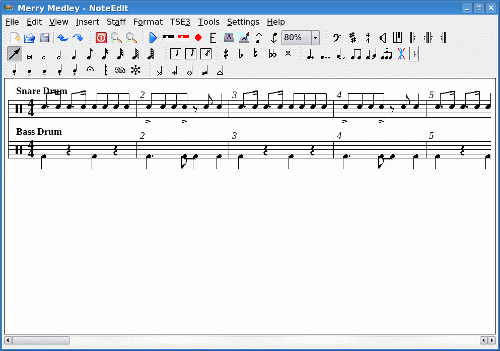
Creating a percussion part in NoteEdit.

1) Drum score created in NoteEdit, 2) exported to abc music, 3) used abcm2ps to create postscript, then 4) used ps2pdf to create the pdf file.
After a couple years, new developers came along and brought many improvements including direct printing through Lilypond or abcm2ps. This was a big development, bringing the possibility of doing all of your notation needs directly from the program and not having to resort to the command line for the final step. But NoteEdit had major structural flaws and lots of bugs which made it very difficult to program. The developers decided to start over. They are now developing a program called Canorus. It looks good, but is still less capable than NoteEdit after over two years of work, and progress is slow. NoteEdit is built with the kdelibs3 so, unless it can somehow be built with static dependencies, it will soon disappear from PCLinuxOS.
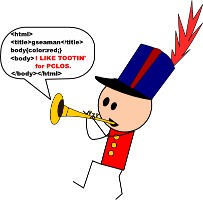
Caricature by ms_meme
As a music teacher, my needs for music notation have included full band, orchestra, choral and jazz ensemble scores. I occasionally could have benefited from guitar tabs as well. Until recently, much of this was still too difficult with Linux. The good news is that music notation has matured to the point that I can do all of these things reasonably well and without excessive effort! We now have many great programs, and with the current rate of progress we will soon have the best programs of any OS.
Music notation can be very complex, so I am not going to attempt to cover all of the features of these programs. Instead, I will just present the basic features and status of these programs so that readers will be aware of what is now available.
Current Status
There are currently two excellent, full-featured graphical notation programs available: MuseScore and NtEd.
MuseScore is very powerful, easy to learn, has excellent midi playback, is stable, cross-platform, and the development team is making fast progress. MuseScore is released under the GPL and available for Linux, Windows and the OSX. The lead developer, Werner Schweer, also is the original author of Muse, a great midi sequencer program. MuseScore is the one I will likely use the most, as I can teach it to students at school or have them install it at home. This is also the only notation program that currently allows manual adjustments of objects on the music. This is not needed most of the time, but it can really come in handy to clean up the look of a score. Much of my arrangements are for jazz / swing and midi playback with 'straight' eighth notes really sounds bad. I just found out the next release has the option of exporting midi files with a 'swing' feel! Many other major improvements are being discussed and are likely on the way.
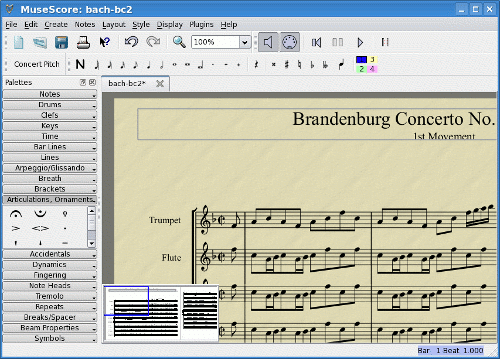
Editing a sample score in MuseScore.
NtEd is also a very powerful notation program. Joerg Anders, the original author of NoteEdit, has returned with great success with this new program. I can only assume from the speed at which Mr. Anders has added features and the compactness of the codebase, that NtEd must be very well designed. The documentation for this program is exemplary in every way. This is a first-rate program and I hope that Mr. Anders will soften his position on cross-platform development. I believe in free software and will not ever go back to using Microsoft software, but as a teacher, I am unable to tell my school and my students they must install Linux. So, I am limited in using NtEd for my own use, and not able to use it for teaching.
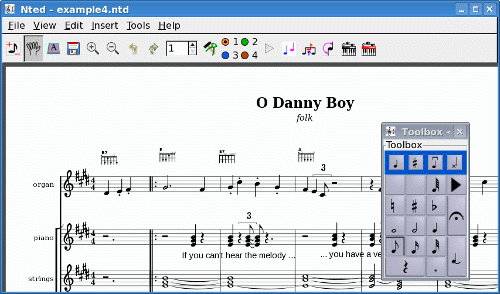
Editing a sample file in NtEd.
Rosegarden is a powerful tool for creating and manipulating midi files. It has the ability to be used as a music notation environment. For me, it is very difficult to get the results that you may want. It does export Lilypond files which can then be turned into .pdf files for printing. But unless you want to hand-edit very complicated files, the output is usually unsatisfactory. This is not to discredit this program, it is just designed for other purposes.
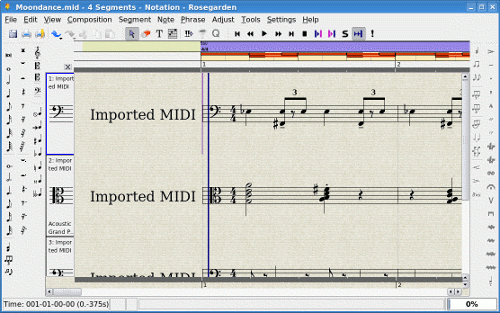
Rosegarden's Score Editor.
Although, Impro-Visor is not technically a notation program, it can compose / generate improvised jazz solo melodies in the style a musician of your choice, which can be exported to MusicXML files and then imported into MuseScore. It will also play the improvisations with appropriate small jazz ensemble accompaniment.
This is an exciting new addition to PCLinuxOS. The primary goal of Impro-Visor is to teach improvisation and composition. This program has been available under the GPL for a while, but to access the source code you had to sign up for a Yahoo! mailing list account. This recently changed, and the program can be directly downloaded and now is in the PCLinuxOS repos.
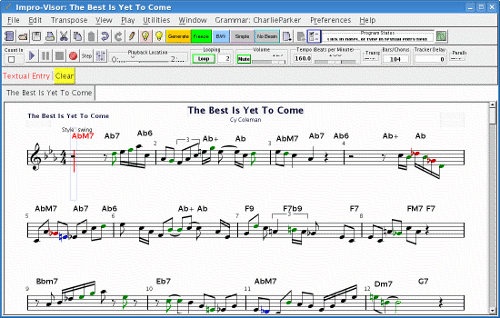
Sample Impro-Visor melody.
TuxGuitar is the first truly successful guitar software in Linux. Previous efforts, like KGuitar, showed potential, but were limited and were never finished. TuxGuitar is a gpl'd java program that aims to be the best in class in guitar tabs and notation. Guitar players use three different ways to display music: standard notation (similar to piano music), chord diagrams (pictures of finger placement to create specific chords to be played), and tabs. Tabs are essentially the fingerings for specific notes. Well designed tabs can be a great benefit to learning new songs. Many of the tabs available online are ascii (text) files and do not show rhythm information. So, to make the most of Tuxguitar, you need to create your own tabs or import PowerTab or GuitarPro tabs. (These are available in many places). Tuxguitar can include notes, chords and tabs simultaneously. It also looks and works very professionally. It is cross-platform and exports MusicXML and midi.
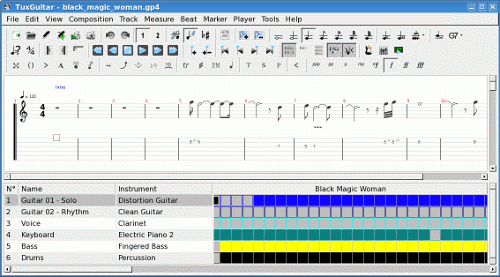
TuxGuitar with standard notation and tabs.
Denemo is designed to be a front-end to Lilypond. I don't know much about using Denemo. It was way too difficult to use for me when I first tried it several years ago. It has had a lot of development recently, but I haven't had the motivation to tried to figure it out, with MuseScore and NtEd progressing so well. The power of Denemo is that it offers access to all of the features of Lilypond. For those that need the power of Lilypond, Denemo may be the best way to get started.
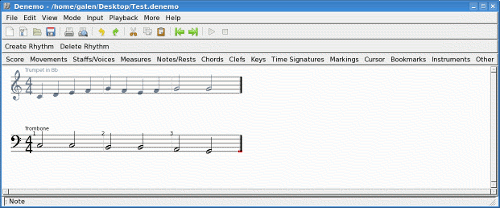
Simple two-part Denemo score.
Lilypond is the most ambitious music notation project in existence. It attempts to automatically create the most aesthetically pleasing and accurate music scores in every style and musical period, without any manual placement needed. Many public domain scores have been made in the lilypond format and can be downloaded from http://www.mutopiaproject.org.
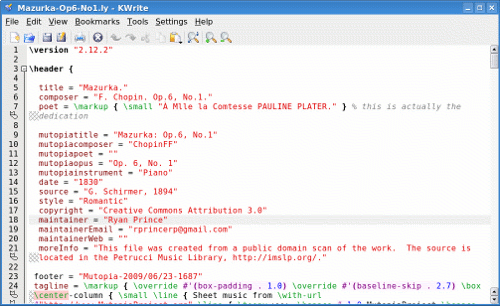
A sample lilypond text file.
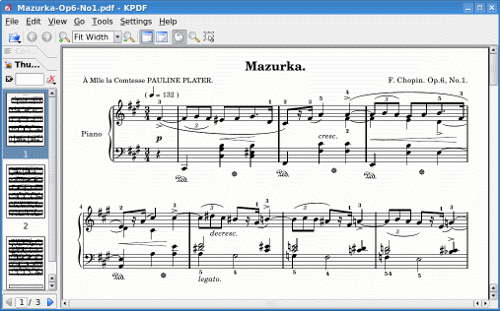
The previous text file converted to pdf using Lilypond.
abcm2ps, which stands for abc music to postscript, is the best pop / jazz music production software that I know. It is much simpler than Lilypond and because the Lilypond authors are focused on classical notation, abcm2ps often looks better with popular and jazz styles. The file format is relatively easy to read and edit directly if you want more control of the output. Unfortunately, at this time, only NoteEdit can create abcm2ps files. Although, you can create music in MuseScore, export to MusicXML files, import into NoteEdit, then export to abc music. This is only worth it if the quality of the output is significantly better than MuseScore can create by itself.
Because only abcm2ps allows you to select the font for the actual notes, it has the ability to create music that looks like professionally created jazz scores. It takes a bit of work to set it up, but once it's done, it's not to hard to repeat.
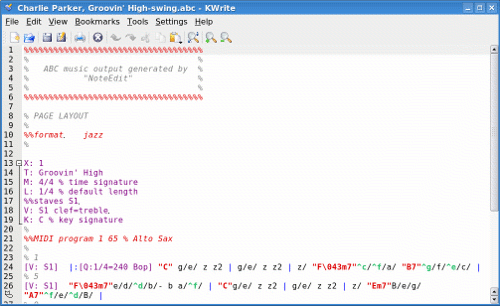
A slightly modified abcm2ps file exported from NoteEdit.
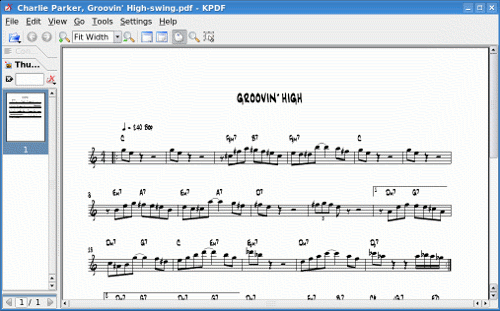
Created by abcm2ps using a jazz stylesheet,
with jazz note and text fonts.
Finally, Canorus is from the development team that kept NoteEdit alive and made some major improvements. Canorus looks good, and seems to have a sound basis, but it is not usable for anything yet. Development is very slow compared to MuseScore and NtEd. (I will not contribute a package for the PCLinuxOS repos until it is stable.)
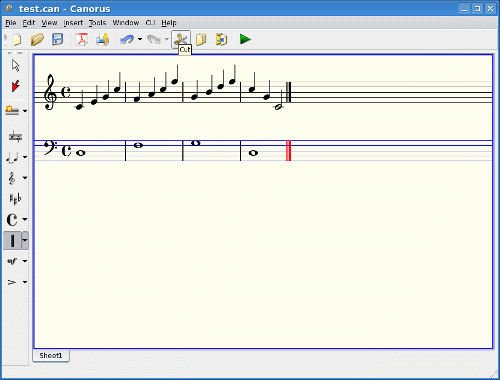
Simple example in Canorus.
